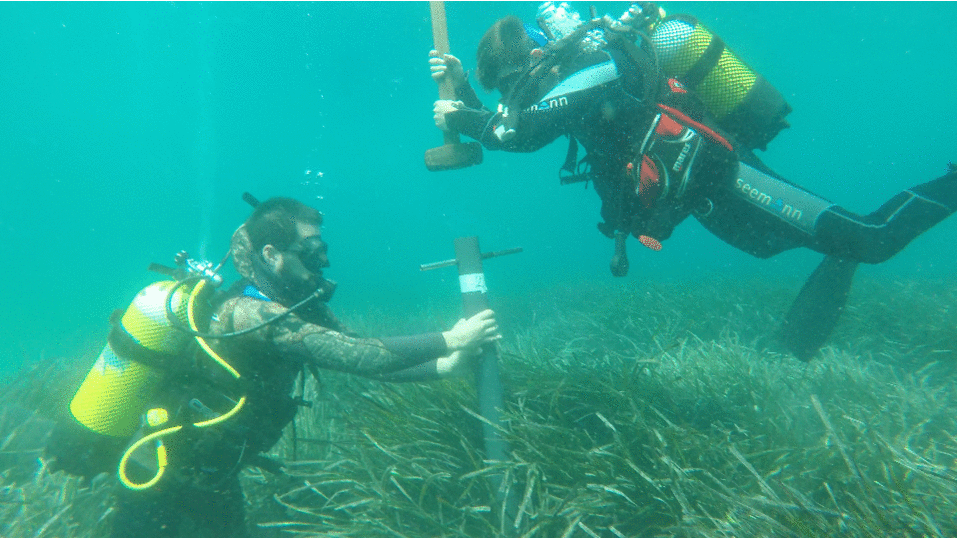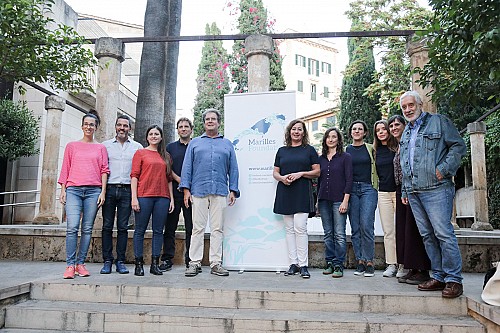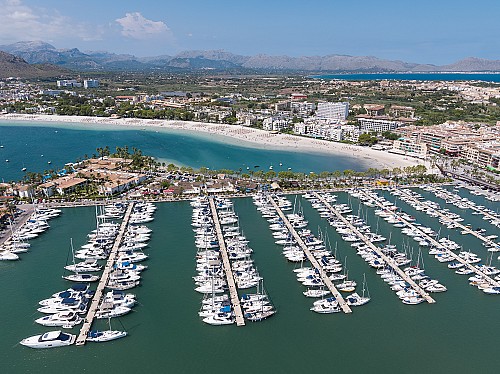The Group of Aquatic Macrophyte Ecology (GAME) of the Blanes Centre for Advanced Studies and Marilles Foundation have today published the results of a study showing that the Illetes Posidonia meadow, in Calvià (Mallorca), is more than 2,000 years old. It is hoped that the results will help to value and protect this natural asset and the multiple services and benefits it provides to Balearic society and the economy.
- Sampling was carried out in July 2021 in the area of Illetes and Portals Nous cove.
- Cores were extracted and subsequently analysed to determine the age and amount of carbon stored.
- The results show that the Illetes (Calvià) Posidonia is 2,355 years old and has an estimated growth of 0.5 mm/year.
- The corrected age for the meadow at Portals Nous (Calvià) is much lower (128 years) with a growth of 5 mm/year (ten times faster).
- The reason for this difference is that the sample taken at Portals Nous grows on a rocky base, which prevents it from accumulating sediment for so many years. However, it has likely been present there for thousands of years.
- The volume of carbon stored by each hectare of 1m-thick Posidonia is about 1,600 tonnes of CO2for both meadows. This amount is equivalent to what 1,000 cars emit in a year.
Miguel Ángel Mateo, head of the Group of Aquatic Macrophyte Ecology (GAME), CEAB-CSIC, and director of the study: ‘The research carried out in the Comtesa and Portals Nous coves of Calvià confirms that their meadows date back thousands of years. During these years they have been providing irreplaceable and invaluable services to the society that lives in and from the coastal resources of Mallorca. Any effort to prevent the deterioration and destruction of this unique ecosystem or to improve the quality of its habitat will undoubtedly benefit everyone in the medium and long term. If we continue as we have been doing, in a few decades we will likely lament the loss of practically all the Posidonia meadows and their associated services. This loss could be irreversible.’
Núria Marbà, researcher at IMEDEA and collaborator in the study: ‘The loss of Posidonia has a double impact on climate. Not only do we stop sequestering carbon, but the carbon deposits that have been stored until now can be released into the water and the atmosphere, so that we have new CO2emissions that we are not counting on now. National carbon reduction plans should take into account the carbon emissions resulting from the loss of Posidonia over the last number of dècades.’
Aniol Esteban, director of Marilles Foundation: ‘Posidonia is a bargain: it improves water quality, protects the coast and fishing resources, regulates the climate, and promotes biodiversity. The services it provides are the basis of key industries for the Balearic Islands, such as tourism and nautical activities. We are unaware of the extent to which the future economic prosperity of the Balearics and the wellbeing of its citizens are intimately linked to the future of this valuable habitat. The Balearics have advanced legislation and an aware population, but much remains to be done. Hopefully, the results of this study will inspire all sectors to further accelerate our collective efforts to protect this species.’

Economic value
For thousands of years, Posidonia meadows have been providing a multitude of services to Mallorcan society. A study funded by Marilles Foundation in 2019 estimates the value of the Balearic Posidonia meadows at €622 million. This value includes coastal protection (€326.9 million), carbon sequestration and storage (€205 million), and water quality (€85 million), but does not include other services related to fisheries production and biodiversity conservation.
Given the extraordinary slownesswith which Posidonia meadows recover (damaged or destroyed areas take decades to centuries), the loss of any piece of meadow and the valuable services it provides is forever. Coastal management policies that reduce the risks and improve the health of Posidonia meadows must therefore be pursued at local, regional, national, and Mediterranean levels.
Further information
- Studies show that Posidonia meadows are being destroyed across the Mediterranean at a rate of 1%–5% per year, with water darkening (eutrophication) and mechanical erosion by coastal works and recreational boat anchors the main causes of destruction in deep and shallow waters, respectively.
- The International Panel on Climate Change (IPCC) report, published in March 2022, recalls that current efforts are below what is needed and predicts that, with the current warming scenario together with other pressures, Posidonia meadows could disappear from the Mediterranean in the second half of this century.
- Posidonia meadows help mitigate climate change because they are very efficient organisms at sequestering and storing carbon and at the same time, they help us reduce the impact of its consequences. In shallow coastal areas, they can attenuate the force of the sea and thus protect our coasts from erosion and the effects of extreme storms, increasingly frequent in the current scenario of global warming.
- Well-preserved Posidonia meadows are more resilient and more likely to recover from certain pressures. For example, a period of water warming above 28 degrees is associated with high leaf mortality; but if the rhizome survives, it can replenish its leaves if conditions improve.
- The Balearic archipelago has 650 km2of Posidonia, i.e., half of all Posidonia in Spanish waters. This area absorbs 7% of the emissions emitted by the Balearic Islands.
- Posidonia oceanicais a species of marine phanerogam endemic to the Mediterranean Sea that breaks all records when compared to other seagrass species. Its larger size, biomass, and longevity, and its peculiarity of forming massive organic structures analogous to coral reefs result in the provision of several valuable ecosystem services.
- To protect and improve the conservation status of Posidonia it is necessary to work at various levels:
- Reduce carbon emissions.
- Improve coastal water quality.
- Reduce the impact of anchoring boats.
- Prevent the movement of fine sediment in shallow-water areas.
Authorship
The study was directed by Dr Miguel Ángel Mateo Mínguez, head of GAME (CEAB-CSIC), with the participation of Dr Oscar Serrano Gras, co-responsible for GAME, the Final Degree Project students (University of Barcelona) Irene Bernabeu Sapena and Enric Gomis Clar, and the collaboration of Dr Núria Marbà from IMEDEA (CSIC-UIB).
Collaborations
The study was conducted in collaboration with the production team of the TV series on the Balearic Sea Arxipèlag Blau: Diego Villalonga, Carmelo Sirera, and Marga Font. The series co-produced by regional television IB3 with co-financing from Marilles is currently in production and will be broadcast at the end of 2022. TrueWorld made the solar boat Stenella available for the sampling campaign. The Conselleria de Medi Ambient and the municipality of Calvià for permits and authorisations, and Port Portals for port services were also involved.
Contact and further information
The study is available at https://marilles.org/storage/media/2022/05/1240/informe-posidonia-milenaria-en-calvia.pdf
Photos and video from the studio: https://drive.google.com/drive/folders/1CW85Bu2A3214-n1rnsI81XJNFK0u_sVu?usp=sharing
Aniol Esteban, director of the Marilles Foundation – 656 192 262 – aniol.esteban@marilles.org
Ana Peña, communication Marilles Foundation – 676 254 404 – ana.pena@marilles.org
Miguel Angel Mateo, CEAB-CSIC – 655 88 35 59 – mateo@ceab.csic.es





